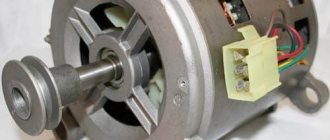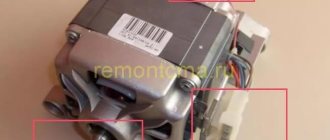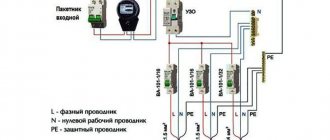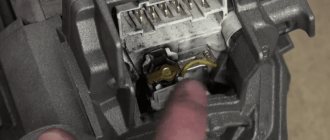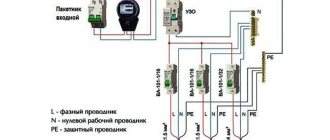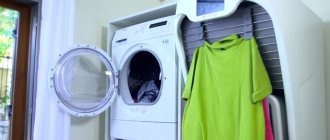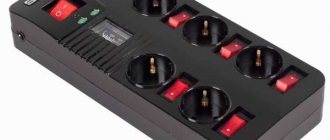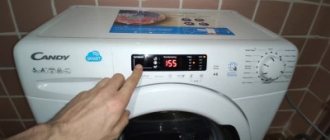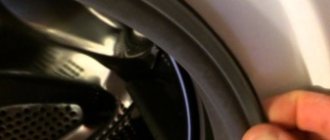The rotation of the washing machine drum is ensured by an electric motor. Initially, belt drives were used to convert electrical energy into mechanical energy, attached to the drum and causing it to move. Today, most older models of washing machines still use this technology, but newer models have evolved significantly. If you need a washing machine repair technician, contact our company. Technical improvement has brought the world three improved types of engines:
- asynchronous;
- collector;
- brushless (direct drive).
Each type of engine has its own advantages and disadvantages, strengths and weaknesses. When choosing a washing machine, you should take these indicators into account.
Engine power of various SMA models
The washing machine motor converts electrical energy into mechanical energy, causing the drum to rotate. There are three types of motors for automatic washing machines:
- asynchronous motors - there are two- and three-phase. The power of such motors for washing machines reaches 180 - 360 W, their speed is not too high - up to 2,800 per minute during the spin process and about 300 during the washing process;
- commutator electric motors - can operate not only from direct, but also from alternating current. They are small in size and the engine speed can be adjusted electronically. The main disadvantage is the brushes, which wear out during use and have to be changed periodically. The power of the commutator motor reaches 380 - 800 W, the armature rotates at a frequency of 11,500 - 15,000 revolutions per minute;
- brushless - they are also called inverter. Such motors first became known in 2005, when Lg began installing them on its laundry washing machines. The main difference is that a belt drive is not required to connect the motor and the drum, everything happens directly. This type of engine is the most compact, structurally simple, and has the highest efficiency. The power of such electric engines are not inferior to the above samples, the number of revolutions in the process of squeezing clothes is 1,600 - 2,000 per minute.
To simplify the issue, let’s figure out how much electricity in kilowatts the motor of your car can generate in an hour of operation. This data interests us more often, but what exactly is the power of the engine itself is a second question.
It is believed that the energy consumption of a device for washing clothes is formed from:
- electricity consumed by the motor, which during operation can vary depending on the operations performed;
- values of a water heating device, the average of which is 1.7 - 2.9 kW. And the amount of energy consumed will depend on the set water temperature;
- the pump power is 24 0 40 W, which is quite enough to drain the liquid;
- the total power value of the light bulbs, module, sensor devices, which reaches 5 - 10 W.
The power of the engine will determine how many revolutions the drum will make per spin. This number is reflected in the SMA spin class. Machines whose motor power regulator allows them to perform 1,600 revolutions per minute belong to group “A”. But this does not mean that you should purchase just such options - even at a mode of 1,000 revolutions, the laundry will be spun perfectly.
We suggest you read: What is the ideal temperature in the refrigerator?
Washing machines from different manufacturers are equipped with electric motors that differ not only in cost, but also in technical parameters. Here are the main devices:
MOTOR CESET MCA 52/64-148/AD9 – such engines are installed on Indesit and Hotpoint-Ariston machines, their power level at 11,500 rpm reaches 430 W;
MOTOR CESET MCA38/64-148/CY15 – motors for units from Kandy, Zerovatt and Hoover companies. At 360 W they produce 13,000 rpm;
MOTOR CESET CIM2/55-132/WHE1 – electric motors of this series can be found on washing units with a power rating of 800 W and a speed of 17,000. Examples of devices are Whirlpool and Bauknecht;
WELLING HXGP2I.05 WASHING – another engine option for Indesit, also found on Vestel. When spinning, the power is 300 W, during washing it decreases tenfold;
Elecronic Control Motor Haier HCD63/39 - this motor can be seen on Kandy or Haier; its power rating is 220 W, speed is 13,000;
HXGP2I Welling Electronic Control Motor - motors of this brand are installed on devices for washing clothes from Samsung and Ardo, their power does not exceed 300 W.
Characteristics of commutator electric motors
These engines replaced asynchronous ones and took their “position” for a long time. Today, about 80% of washing machines in the low and medium price segment are equipped with just such electric motors. The operation of collectors can be ensured by both direct and alternating current.
As already mentioned, the commutator consists of a stator, a tachometer that regulates the rotation speed, a rotor, bearing shields and at least two brushes. Graphite rods tend to wear off, so they need to be changed periodically.
Among the advantages of collectors are compact dimensions, high starting torque and speed. A simple control circuit will also be a plus.
You can understand the technical characteristics of engines of this type using the example of a manifold model DK76-280-12. The main indicators are:
- rated operating voltage – 210-230 Volts;
- frequency – 50 Hz;
- power – 0.5 kW;
- current consumption – 2.25-2.75 Amperes;
- Efficiency – no less than 55%.
The average maintenance-free service life of commutator electric motors is 5 years.
The rotor of the DK76-280-12 commutator is a 12-slot package made of durable electrical steel, mounted on a shaft. The grooves contain a two-layer winding. On the armature shaft there is a fan necessary to supply cooled air. This engine has sliding bearings as supports - they are installed in special sockets.
The connection between the rotor, stator and external winding is provided by electric brushes located in special side holders. During operation, the tips wear out, so they require periodic replacement. Another disadvantage of collectors is increased noise.
Typically, the power of collector motors installed in automatic washing machines varies from 380 to 800 Watts. Therefore, before reusing a dismantled power device, it is better to find the markings on the case and study in more detail the characteristics of a particular model.
Before connecting the motor outside the washing machine, figure out which output of the collector is intended for what. A pair of contacts are needed to connect the tachogenerator, so most likely they will not be needed. The remaining outputs are used according to the diagram.
By drive type
Drives are divided into:
The simpler the drive, the more reliable it is. This option includes a direct drive, which is attached to the drum axis and is quieter, frees parts from additional load, increasing service life, and reduces vibration. But, despite the huge number of advantages, machines with such drives are produced only by well-known brands, and their range is very small.
A brushless motor is also called an inverter motor or a direct drive motor. This is the latest technology developed by the Korean concern LG. The spread of this type of motor began in mid-2005, and since then, thanks to its excellent performance, durability and compactness, the inverter drive has firmly occupied a leading position.
Today, other companies use this technology, including Haier, Samsung and Whirpool. Reliability, significant superiority of direct drives over commutator and asynchronous motors, the ability to greatly reduce the size of washing machines, wear resistance, a small number of parts and other advantages have significantly expanded the scope of brushless motors. They were appreciated and began to be used in equipment from Bosh and AEG.
The design of such a motor consists of only a rotor and a stator, just like an asynchronous one. However, its effect is completely different. The drive is connected directly to the drum, which eliminates the use of connecting elements - the most vulnerable parts of the motors. The control circuit in such motors is of a three-phase inverter type.
The main advantages of motors of this type are:
- simplicity of design;
- convenient location in the washing machine;
- compactness;
- low vibration level of the machine;
- Efficiency is higher than that of other types of engines;
- no belt or brushes that require regular maintenance;
- relative noiselessness.
The engine is the “heart” of the washing machine, one of its main components, on which the performance of the equipment depends. The main characteristics of this part are power and number of revolutions per minute.
When buying an automatic machine, we rarely pay attention to these parameters. Or maybe in vain? That’s why we decided to talk about how much power the engine has in a washing machine, and what it affects
Checking the functionality of the mechanism
There are machines on sale only with inverter and commutator motors, so we will consider these two varieties, leaving out the asynchronous one.
We are looking for a breakdown of the direct drive motor
The inverter is not intended for home repair. The best option is to try system testing, if your machine model is capable of this.
Self-diagnosis will display a fault code, its decoding and will help you understand where the problem is and whether the services of a specialist are needed.
The testing method and error codes are different for each machine. Before testing, you need to empty the drum of laundry and close the hatch tightly
If you still want to remove the inverter, follow the correct algorithm:
- Disconnect the device from the power supply. It is recommended to wait a few minutes until all elements are completely de-energized.
- Unscrew the bolts and remove the back panel.
- We find the screws under the rotor that secure the wiring and unscrew them.
- Before disconnecting the wires, we take photographs or sketch them, so that later we can correctly connect all power sources.
- Remove the central bolt that holds the rotor. During the process, you need to hold the rotor to prevent rotation.
- We remove the rotor assembly, and behind it the stator.
- Disconnect all wire connectors.
Now you can inspect the engine. It is unlikely that it will be possible to thoroughly test the operation of the inverter. What can be done? Check the integrity of the rotor winding.
The Hall sensor often breaks down in such engines. Whether it is operational can only be determined in a workshop if the part is replaced with a new one.
We carry out diagnostics of the belt drive
To check the collector, you must first remove it from the housing. To do this, remove the back panel, disconnect the wires and unscrew the bolts. It is permissible to pry with a screwdriver in the places where the bolts are attached, where dirt often accumulates and sticking occurs.
Now let's start diagnostics. We connect the wires of the stator and rotor windings according to the diagram. We connect it all to electricity. There is nothing wrong with the device if the rotor starts rotating.
This testing method has its own characteristics: it is impossible to test the operation of the engine in different modes, plus there is a risk of a short circuit from direct connection
To avoid a short circuit, you can connect a ballast in the form of a heating element to this circuit. We connect the ballast from the rotor side. It will begin to heat up, thereby protecting the engine from combustion.
The collector is a structure of several parts and they all require inspection. First in line are the notorious brushes. They are located on the sides of the body. We take them out and inspect them.
If they are worn out, they need to be replaced. A clear sign of such a need is that the engine sparks when rotating. To buy new brushes, take your old ones with you and write down information about the model of the washer.
The next element is the slats. They serve as current transmitter conductors to the rotor. These parts are glued to the shaft and if the motor jams, their detachment is possible.
If you have access to a lathe, it can be used to remove minor flaking. Don't forget to clean off the shavings with fine sandpaper.
Pay close attention to burrs and peelings on the lamellas; they are often the cause of unsatisfactory operation of the washing machine motor.
Now let's move on to the stator and rotor windings. If a short circuit occurs in them, the collector heats up, which causes the thermistor to operate. The result is that power is lost or the mechanism stops working altogether. We test the windings with a multimeter in resistance mode.
The stator is checked in buzzer mode. The ends of the wiring are tested one by one with probes. If there is no signal, the part is fine. You can determine the location of the short circuit by connecting one probe to the wiring and the second to the housing.
The probes are applied to the engine lamella. The display shows less than 20 Ohms - we have a short circuit, more than 200 Ohms - a break in the windings
If the device is silent, this is normal. If a breakdown is detected, you will need to create a new winding to repair it yourself, and this is difficult for a non-specialist.
If you still need to replace the engine, it is usually enough to simply install a new part in place of the old one. After all the manipulations, do not forget to turn on the machine and check its operation.
Inverter motor - a successful development
The efforts of engineers led to the invention, among others, of an inverter motor in a washing machine. Thanks to its appearance, new generation machines have surpassed all previous models in energy efficiency by as much as 20%.
In addition, another “bonus” has appeared - automatic shutdown, which helps save on electricity bills.
Features of inverter motors:
- The induction motor is not equipped with brushes, which means they will not wear out. Nothing will have to be changed, as in brushed and brushless motors.
- A machine with such an engine spins at a speed of 1600 revolutions in 1 minute - the laundry coming out of the drum is almost dry.
- Washing machines with inverter motors, again due to the absence of brushes, have become famous for being silent. Depending on the selected mode – “Wash” or “Spin” – the noise level fluctuates in the range of 53-76 dB.
Inverter motor saves water
Thanks to the modified design and slight tilt of the drum, you can significantly save water. Maybe for some 10% will not be an impressive figure, but for users who actively use the machine, this will be a compelling argument.
The drum of the machine with an inverter engine also allows you to conveniently load and unload things for washing.
Increases washing efficiency
“Faster, higher, stronger” - this almost Olympic principle is implemented through the Beat Wash system, which involves the presence of a 3D sensor. This is what increases the efficiency of washing.
The system can make adjustments to the trajectory of items moving along the drum in order to achieve ideal laundry balance. All this provides the so-called “three-dimensional” washing.
- Washing becomes delicate: the laundry does not wrinkle or curl haphazardly.
- The system adapts to the washing and characteristics of different types of fabric.
- Beat Wash can reduce the time required for a cycle depending on the type of laundry loaded.
All about the inverter motor
Let's look at what an inverter motor is in a washing machine. The principle of operation of such an engine is that a frequency converter, more simply an inverter, is responsible for its speed.
Its task is to convert alternating current into direct current, and then to generate alternating current of the required frequency. The good thing about the process is that the engine speed is controlled with high precision to maintain the required frequency.
The main feature that distinguishes an inverter motor from any other is the absence of brushes. The rotor of the engine, as in all others, rotates according to a single principle - under the influence of an electromagnetic field.
Pros:
- High coefficient of efficiency (efficiency).
- Durability (no replaceable parts).
- Accurately maintain the required speed and instantly reach the desired speed.
How to extend the life of the washing machine motor?
Maintaining electrical safety will not only protect you from accidents, but will also extend the life of any type of motor. The performance of the washing machine is also affected by proper operation by the owner.
Step #1 - properly connect to the power supply
To properly connect the machine to the network, you need to meet only 6 criteria.
The first thing we will pay attention to is the power, cross-section and brand of wires. The power of most models ranges from 2000-2500 W. By power we determine the cross-section of the supply wires. Tables with the necessary parameters can be found in GOST 31946-2012.
A two-core aluminum cable is not suitable for powering the washing machine socket; you need to lay a copper and three-core cable. Most often, we have copper cables installed in our apartments with cross-sectional parameters of 2.5 square meters. mm.
This line can be protected using a circuit breaker with a rated current of 16 A.
Now you need to determine the brand of the supply wire, based on the power and cross-section. The PUNP wire cannot be used.
Many modern models of machines have first class protection against electric shock. This is ensured by protective grounding - there is a special contact on the power cord plug
The next point is grounding. If there is no grounding in the house, you need to take care of this yourself. You can separate the PEN conductor so as not to have problems with this.
You will also need a grounded outlet. The ideal option is with ceramic fittings and a higher protection class for rooms with high humidity (if the outlet is in the bathroom).
It is better not to use a tee, adapter, or extension cord for connection. And if there are frequent power surges in your home, connect the machine through a converter.
It is recommended to purchase an RCD - an automatic device that turns off the power in case of problems in the network. Its parameters should not exceed 30 mA. Ideally, if you can organize power supply for the washing machine from a separate group in the electrical panel.
It is strictly forbidden to make grounding by connecting the body of the machine and heating or water pipes. And the second taboo is installing a jumper in the socket, where there is a zero and a ground contact.
Do not confuse grounding and working zero, the grounding wire cannot be grounded to zero, connect each core to its “own” bus, otherwise you will get a short circuit
Step #2 - operate the equipment carefully
There are also certain operating rules that affect the operation of the engine. Children should not be allowed to play with software buttons. Do not open the detergent compartment while washing.
Prohibitions also include sudden program changes. If you have a manual machine, do not turn the program dial counterclockwise.
An important rule for using a washing machine is proper loading. Do not overload the drum when washing, try not to use maximum spin
Advertising tricks of manufacturers
In the instructions for washing machines, manufacturers indicate all the parameters and characteristics, and the user, studying them, realizes how much new products benefit in many respects, such as energy efficiency and durability. Companies under no circumstances deceive customers, but sometimes they leave out small nuances that significantly reduce the value of new technologies. This is done for advertising purposes to increase sales.
Energy efficiency
As the advertisement says, inverter machines help save up to 20% of electricity compared to collector models. Yes, this is indeed true and the savings occur due to more precise adjustment of the load on the motor - with a small load of laundry, the drum is not fully spun up and energy is saved.
But the most important thing is that in the machines, the largest amount of electricity is consumed not by the motor, but by the heating elements that heat the water. Therefore, real savings are 2-5%, and when fully loaded they are reduced to zero.
Silence
Brushed motors make a lot of noise, while inverter motors operate as quietly as possible and do not make any sounds. This is partly true, motors with brushes are noisier, but inverters also have a characteristic squeaking and whistling sound.
Spin speed
The new products can actually spin clothes at the highest speed, reaching 2000 rpm. This is a very significant advantage of an inverter washing machine for buyers who dream of quick washing and almost dry laundry. But few people know that with such a spin speed, things quickly become unusable and sometimes, instead of a well-wrung item, people take out shreds of it. And delicate or woolen items a priori do not require a strong spin, so think about how necessary such speeds are.
Durability
Now ask yourself a question: how long do you want to use your washing equipment? Typically, users expect a maximum of 15 years, but even during this time, technology will make significant progress and new, improved and more technologically advanced models will appear. A service life of 10-15 years is established for the commutator drive.
Most buyers worry about brushes that wear out, but their service life is up to 15 years with a daily load of two hours. Even if they wear out, the cost of replacing them is negligible.
Another point that affects durability is the combined location of the drum shaft and engine. Indeed, such an arrangement has a lot of advantages and the absence of various additional loads, and an increased mechanical life, but there is also a minus - one, but significant.
No rubbing parts
This statement can be called an outright lie. There are no brushes in the inverter motor, but there are bearings and they have the same service life and wear rate as in conventional motors.
Manufacturers provide warranties for inverter motors for up to 10 years, but for other parts of the washing machine, warranties are limited to 3-7 years. Equipment is also affected by such factors as, for example, voltage surges, which reduce all newfangled technologies to banal breakdowns not included in the warranty service. And the cost of repairing inverters is very high. Therefore, it is recommended to correctly connect and install the washing machine, as well as operate it carefully, following the basic rules, and the equipment will delight you for many years.
Source
Main causes of electric motor malfunction
The main reasons for a washing machine motor failure may be as follows:
- Malfunctions of the collector lamellas,
- Breaks in rotor and stator windings,
- Worn motor brushes.
Lamella malfunctions most often occur due to short circuits in the windings.
Broken lamellas
Due to breakdowns, the lamellas may lose contact with the rotor winding section. They can also heat up too much and even peel off. The lamellas are fixed to the collector with an adhesive. And the electrical connection with the sections of the rotor winding is created by special hooks. One of the most common failures of this engine part is the breaking of the cord in the rotor section at the junction with the lamella.
It is much worse if, due to excessive heating, the lamella has peeled off. Such a breakdown occurs due to short circuits in the winding sections, between the lamellas and rotor jamming. This defect occurs because electricity passes through the lamellas significantly above the operating level.
This can happen when the bearings jam or when a top-loading washing machine starts washing with the drum flaps not locked in the closed position. More often than not, this defect in the lamellas tells us that there are some other breakdowns of the electric motor or that the machine is not being operated correctly.
Minor delamination, not exceeding half a millimeter, is removed by grooving the collector on a special machine. After this, you need to carefully inspect and clean all parts of the part from dust and chips and remove burrs.
In order to determine the presence of this malfunction, you can slowly rotate the rotor with your own hands. If you hear a characteristic cracking sound, then most likely there is a problem.
Worn motor brushes
If the washing machine motor brushes are worn out, then it’s time to replace them with new ones. You can find new brushes in specialized stores. They can also be purchased to order. The easiest way to find suitable parts for a washing machine is to use search engines on the Internet. In Google or Yandex search results you can find organizations that sell these spare parts. And by calling them, you can find out if the brushes you need are in stock or place an order for them.
By the way, quite strong sparking can occur when the brushes are still new and have not gotten used to the internal parts of the engine. Another reason to decide that the brushes are worn out is incomplete rotation of the machine drum. Quite often this happens when there is a problem with the drive belt. For example, when it breaks or slips off a pulley. Also, the cause of what is happening may be a short circuit between the turns of the engine winding.
In most cases, brushes from other motors will not work. It is necessary to purchase brushes designed specifically for your motor.
The hardness of the brushes can affect how long they will last. But very hard brushes can damage the commutator over time.
Short circuits and breaks in rotor and stator windings
Has the engine become less powerful? Short circuits occurring between the turns of the winding are possible. As we already wrote above, in the event of such a breakdown, the drum of the machine may not rotate or may not rotate completely.
Has the electric motor stopped working? Most likely, there was a break in the stator windings. This can also happen due to too much heating of the motor housing due to short circuits in the same motor windings. If the engine has heated up to a temperature of over ninety degrees, a special thermostat designed for protection will operate. The normal temperature during operation of the electric motor should not exceed eighty degrees. As you have already read above, if the engine overheats and short circuits, the lamellas may peel off.
In addition, short circuits in the washing machine motor winding may occur due to insulation failure. Unfortunately, in this case the entire engine will have to be replaced. Or re-create the winding. Which is not very easy. And we don't recommend doing it yourself.
A short circuit in the engine of the machine can cause many other malfunctions. For example, the contacts of the control module connectors may become unusable, the power triac, reverse relay, etc. may fail.
Which car with an inverter motor to choose
The modern market is overflowing with household appliances. In this regard, people have a question: “Which machine to choose?” The housewife should compare all the characteristics to choose what is most suitable.
Indesit machines are equipped with additional functions that save energy. In addition, they have a mode that allows you to deal with dirt and grass marks. This function will be useful for those who have athletes in their family. If you wish, you can even wash your sneakers. The inverter motor handles the load perfectly.
Another leader is Bosch. In addition to the silent engine and original design, the advantage of these machines is that they are capable of washing up to 10 kilograms of laundry at a time. The drum does a great job with carpets, long curtains and other bulky items.
Each housewife must choose the machine that suits her best.
Types of devices to check
In addition to the standard set of tools (pliers, a set of screwdrivers and wrenches), you will need an electrical device that performs the “diagnosis test” of the motor.
Multimeter
Previously, a multimeter was called an avometer - it was a pointer device that measured resistance, voltage and current. Today, pointer instruments have almost completely disappeared from the market - with the exception of miniature, modern versions, which are difficult to find. They have given way to digital counterparts that allow you to check diodes, capacitors, inductors and windings, and even the health of transistors.
The same as a multimeter, but can be made independently - from any pointer galvanometer. To carry out measurements, the tester switches to the resistance measurement mode (values on the sector with the designations Ohm and kOhm).
The device received the name “continuity” because of its buzzer mode: when the resistance is below 200 Ohms, an audible alarm is activated.
Engine from an old washing machine characteristics - Machine tools, welding, metalworking
Any washing machines become unusable after a certain period of time, and most often they are simply sent to a landfill. But some details from it can be given a second life.
For example, an engine from an old washing machine that has broken down can become the basis for a new homemade device or tool. There are many different options for using it to benefit your household.
True, all this depends on the imagination and skill of the home craftsman.
The type of electric motor chosen for homemade products depends on the age and model of the washing machine. For example, if it was an old washing machine dating back to Soviet times, then it most likely had a reliable asynchronous electric motor installed.
This washing machine motor has a power of 180 W, has excellent torque and is the most convenient motor for homemade products.
Also in the hands of the master may be a two-speed electric motor, a commutator motor or an engine from a modern SM of any model and class.
Second life of an electric motor
From an old, out of order washing machine, it is possible to make many homemade items for household needs. Many of its elements are suitable for this, including the body, drum, covers, etc. But units are most often made for use in household purposes, home workshops or garages - using a motor.
You can use the electric motor from a washing unit, for example, by making a homemade juicer for the kitchen, a vibrating table for the workshop, as well as making many other useful devices and accessories that can greatly simplify certain types of work for a home craftsman.
Characteristics of inverter electric motors
Around the 2000s, with the development of semiconductor devices, frequency converters began to be widely used. Such devices are able to change the frequency and adjust the voltage over a wide range; indicators can vary from 1 to 500 Hz.
The inverter engine is not “powered” directly from the mains, but rather from the converter built into it. The device independently adapts to the operating mode and produces a voltage of the optimal level and the desired frequency. Therefore, an inverter is 2 devices combined in one housing.
The use of inverter technology makes it possible to obtain a wide spread of speeds and the possibility of multi-level operation of the electric motor. The built-in converter allows you to adjust the voltage, thereby achieving optimal torque. Of course, all this is carried out within certain limits, but the overall performance characteristics of such motors are much better.
Due to a more complex device, the price of inverter motors is higher than that of collector and asynchronous motors.
The inverter converter adjusts the voltage in two stages:
- takes the mains voltage and converts it to constant;
- creates a stream of positive and negative impulses from constant voltage. At this moment, the required frequency is obtained, which is supplied directly to the engine.
Some inverters have one more conversion stage. At the final stage, the pulses are “added” into a sine wave. But the form of the supplied voltage does not have much effect on the operation of the engine, so this process is not provided for on many engines.
Due to the technical features of inverter motors, it becomes possible to control their operation over a wide range. The motor can independently regulate rotation speed, convert voltage, etc.
Interesting:
- What can be done from an old washing machine
- How to choose a brand of washing machine?
- Comparison of technical characteristics of washing machines
- How to start a washing machine motor?
- Where can I use the motor from an automatic washing machine?
- What is the power of the washing machine motor?
Reader comments
- Share your opinion - leave a comment
Types of washing machine motors
The electric motor of the washing machine is a reliable part that very rarely breaks down. Therefore, motors from machines that have been used for 20-30 years are quite suitable for recycling. With their help, craftsmen construct lathes and emery machines, apple and grain crushers, small concrete mixers, lawn mowers and other useful household devices.
Let's figure out how electric motors differ, what features are typical for certain power devices. Let's tell you what elements different engines consist of.
Commutator motors are considered the most common today; they are found in most automatic machines. The design of such an electric motor contains:
- aluminium case;
- rotor;
- stator;
- two brushes;
- tachometer.
The number of leads for such motors can be from 4 to 8. Electric brushes are necessary here to create a connection between the rotor winding and the motor. The collectors are installed at the bottom of the automatic machine. Impulses from the engine are transmitted to the drum pulley via a belt drive.
Inverter motors are considered the most modern. They first appeared in cars of the South Korean brand LG in 2005. Today, this innovative development is already used by many manufacturers - machines with a direct drive system are produced by the brands Bosch, Samsung, Haier, Whirlpool, AEG and others.
Inverter motors are connected directly to the drum. These machines do not have a pulley or drive belt. The design of electric motors of this type includes:
- rotor (it is a cover with magnets);
- stator (these are several cages with coils);
- a frequency converter.
Inverters do not have brushes, which on the collectors have to be changed every 3-5 years. The armature is formed on magnets. During operation, the voltage is directed to the stator winding, converted into an inverter form.
Asynchronous motors are now almost never used in the production of automatic machines, but they are what are used in old activator washing machines. Such engines come in two- and three-phase types. You can find engines of this type on early models from Bosch, Kandy and Ardo.
The asynchronous engine in the machines is located at the bottom, it communicates with the drum through a drive belt. The design has a rotor and a stationary stator. Such engines are simple and easy to maintain. If bearings are changed in time, the devices can operate for decades without complaints.
Characteristics of asynchronous electric motors
On the earliest models of activator washing machines from the brands Bosh, Candy, Miele, Ardo you can find asynchronous motors. These are the most primitive electric motors with the simplest design. Such power devices are capable of operating at ambient temperatures from -60 to +85 °C.
According to its design, an asynchronous motor consists of two main parts - a rotor and a stator.
The stator of an electric motor is a stationary element consisting of a metal body and winding. An engine rotor is a rotating part that contains a core and a shaft. The core is made of several steel plates and is necessary as the basis for the rotary electrical winding.
The scope of application of such engines is quite wide. Using an asynchronous engine from an old machine, you can make a lathe or sanding machine, a pumping station, a lawn mower, a fan, a gearbox and other systems. This is why craftsmen never throw away the electric motor from a broken washing machine, but give it a “second life”.
The general technical characteristics of asynchronous power devices found in activator washing machines are as follows:
- power – from 180 to 360 Watt;
- received voltage – 220 Volts (+-22 V);
- synchronous rotation speed – up to 3000 rpm.
During operation, an asynchronous motor produces noise within 50 dBA. Some models of power devices may have built-in temperature protection. Manufacturers usually set the following restrictions on the use of such electric motors:
- up to 30 starts per hour;
- no more than two hundred launches in 24 hours;
- the total number of launches per year is no more than 30 thousand.
At operating temperature, such engines are capable of withstanding an increased rotation speed of 20% of the standard speed for 120 seconds without any deformation or other damage. They can also “resist” a fifty percent overcurrent for 2 minutes. All this indicates the high reliability of power devices of this type.
Types of engines
The conversion of electrical energy into mechanical energy (rotation of the drum) in a washing machine occurs due to the engine. Engineers have developed three types of engines that are used in automatic cars:
- asynchronous motor;
- commutator motor;
- brushless motor.
Asynchronous type motors can be two-phase or three-phase. Modern washing machines manufactured after 2000 do not use two-phase motors. The power of such engines is 180-360 W, the number of revolutions is not high and does not exceed 2800 revolutions per minute during spinning; when washing, the revolutions are about 300. In machines with such an engine, spinning is only 400-600 revolutions per minute, in rare cases 800- 1000.
Asynchronous motors have practically been replaced by brushed motors, which are capable of operating on both alternating and direct current. They are smaller in size and have smooth electronic speed control. The main disadvantage is its design, which includes the presence of brushes; they wear out and become unusable. To restore engine performance, they need to be changed periodically. The power of commutator motors is 380 - 800 W, while the armature rotation speed varies from 11,500 to 15,000 rpm.
The brushless or inverter motor first appeared in washing machines in 2005, and LG was the first to use it. Its difference is that it is directly connected to the drum without a belt drive. It is more compact than the other two types of engines, simpler in design, and has the highest coefficient of efficiency (efficiency). In terms of its power, the inverter motor is not inferior to the previous ones and is capable of spinning the drum during spinning up to 1600-2000 rpm.
Dependence of energy consumption on power
Energy consumption as a whole depends on the power of the electric motor of the washing machine; in other words, how many kilowatts of energy the machine generates per hour. This is what interests the consumer most often, and not the power of the automatic machine’s motor. The energy consumption of the machine consists of:
- engine power consumption, during the entire wash it changes, during spinning more, during washing and rinsing less;
- heating element power, which averages from 1.7 to 2.9 kW. Moreover, the higher the water heating temperature, the greater the power consumption;
- the pump power, which is 24-40 W, is quite enough to pump out water;
- total power consumed by light bulbs, control module, sensors, etc. it is approximately 5-10 W.
The power consumption of the washing machine is calculated for the “Cotton” mode, in which the water is heated to 60C and the machine is loaded to its maximum. Based on this indicator, the washing machine is assigned an energy efficiency class, denoted by a Latin letter.
The more powerful the engine, the more revolutions the drum will make when spinning the laundry. This indicator is reflected in the spin class of the washing machine. Automatic machines rotating at a speed of 1600 rpm belong to class A. But it is not at all necessary to buy such a machine, because even with a spin of 800-1000 rpm, the laundry will be wrung out well, without the risk of being torn.
Motor power of different models of washing machines
Washing machines of different brands have different motors, so they have different technical characteristics and different prices. Let's give a few examples.
- MOTOR CESET MCA 52/64-148/AD9 – motor installed on Hotpoin-Ariston and Indesit washing machines, its power is 430 W and 11500 rpm;
- MOTOR CESET MCA38/64-148/CY15 – motor for the Candy, Hoover, Zerovatt washing machine, power is 360 W and 13000 rpm;
- MOTOR CESET CIM2/55-132/WHE1 – electric motor for Whirlpool, Bauknecht washing machines, power 800 W and 17000 rpm;
- WELLING HXGP2I.05 WASHING – motor for the Indesit or Vestel washing machine, spinning power 300 W, washing power 30 W;
- Electronic Control Motor Haier HCD63/39 – motor for Candy and Haier machines, power 220 W and 13,000 rpm;
- HXGP2I Welling Electronic Control Motor – motor for Samsung washing machine, power 300 W.
So, automatic washing machines produced in the 2000s have a brushed or brushless motor. Their power consumption may vary, but for the consumer this does not matter much. It is more important to know how energy efficient a machine is, and this can be determined by the energy consumption class, which modern machines have A or A+.
Share your opinion - leave a comment
Verification options
Almost all Bosch washing machines are equipped with commutator-type motors that spin the drum through a belt drive. The advantage of these motors is that they can be tested at home. The main thing is to study the electrical circuit diagram of the engine and remember the safety rules. The connection in most commutator motors is organized according to the following scheme:
So, a certain sequence is observed. The 220 Volts supplied to the motor are first supplied to the control triac, after which the current goes to the reverse relay contacts (II or I), then to the stator winding and rotor. The signal to switch modes and vary power is supplied by the control board through a transformer and contact groups of the command device. The tachogenerator located on the housing regulates the acceleration speed of the engine, and the outgoing friction force of the electric brush smoothes out.
The stator winding has two sections, which reduces the likelihood of interference that may occur due to sparks on the commutator. By changing the polarity on the wire, the side of rotation of the drum is changed. When switching to spinning, the provided outlet is activated. In this case, electricity is connected to one of the outer terminals and the outlet itself. If the latter is lowered, it means that the washer operates only in the standard mode, while the shaft movement is slow and smooth.
To test a commutator motor with your own hands, you need to supply electricity directly to the device. The discharge occurs when connected to the stator and rotor windings in series. A working motor will hum and start working; when it closes, heating of the circuit will be noticed. Schematically this connection looks like this:
There is another option for diagnosing the engine. We connect the stator and rotor windings in the manner described above, but as a power source we use a special autotransformer with a power of more than 500 Watts. This path is considered safer, as it allows you to better control the acceleration of the motor and respond in a timely manner to unforeseen situations. Ideally, you should play it safe and include a 5 or 10 Ampere fuse in the circuit.
In the absence of a transformer, an electronic regulator is used. With its help, it is easier to control the power of the given load, preventing the motor from overheating. It’s interesting that you can make such a device yourself: you just need to find the appropriate diagram on the Internet.
It is easier for beginners to test the motor visually. For example, after starting the engine, evaluate how much the commutator brushes spark. If there are a lot of sparks, it means that there is a failure in the system - it is necessary to disassemble the engine and carry out advanced diagnostics.
Differences from belt drive
Washing machines that have direct drive or a special belt have many differences. Let's focus on the main points.
- A direct drive has a direct connection between the rotor and the drum axle. In the case of belt-type units, the belt connects the pulley of the tank and the engine, due to which the drum rotates and stops.
- The engine in direct drive models is located under the tank and leads to strong friction of adjacent parts - bearings. Belt versions use special brushes that are designed to smooth out friction and also limit the transmission of current.
- The difference between belt and direct drive models lies in the price. The first options are usually cheaper than the second.
- Direct drive washing machines usually have more capacity. But belt models cannot boast of this, since in the design of the equipment a lot of space is allocated for installing brushes, belts and a pulley.
- Belt-type washing machine models usually operate quite loudly, creating strong vibrations. This problem is not typical for direct drive units.
- Direct drive machines have more powerful motors compared to non-drive devices.
- Designs without a belt drive are more stable, so direct drive models are more balanced than those with a belt.
- Repairing a belt machine is always cheaper than repairing modern direct drive machines.
We suggest you read How to remove a clip from clothes
Causes of breakdowns and ways to eliminate them
| Cause | What to do? |
| Breakage of lamellas (contact plates) in the collector |
|
| Break in the rotor or starter winding | |
| Wear of electric brushes |
|
The video will tell you how you can diagnose engine problems yourself, without calling a technician to your home.
The best posts
- How to make a plasterboard box in the bathroom - step-by-step instructions
- Drywall figures or how to make the interior stylish and fashionable
- DIY decorative corner fireplace made of plasterboard
- Wiring under drywall: lay it out correctly
- Painting drywall - step-by-step instructions
- How to join drywall in corners and the process of building a decorative niche
- Socket boxes for drywall: correct selection and installation
- How to cover a radiator with plasterboard without losing heat in the room
Related article: Washing machine hums during spin cycle
Conclusions about engine power
How to find out how many revolutions a washing machine motor has? How to determine motor power? How can you avoid making mistakes in choosing technology based on this?
It's simple: washing machines made after 2000 are supplied to stores with brushed or brushless motors. Their power may differ, but this is not the most important indicator for the consumer, since the more pressing issue is the optimal energy efficiency class.
Therefore, if you don’t want to understand the technical nuances of motors, just choose a class A or A+ machine.
A useful video will tell you even more about the SM engine:
How much does SMA consume?
When choosing a washing machine, buyers evaluate it according to a standard set of criteria. Usually they are interested in modes, drum loading, dimensions, loading type, drum illumination and other visible functions. But people are rarely interested in kilowatts. The lower the energy consumption class, the more electricity is spent, the higher the electricity bills. Today, almost all SMAs belong to group A. The exception is devices with a drying function - but here you have to sacrifice savings for the opportunity to receive dry laundry.
Energy consumption can be easily determined by the energy efficiency class. Thus, models A+++ consume 0.13 kWh, and, for example, group C - 0.25 kWh. Power consumption of class A SMA is up to 0.31 kWh. Equipment of groups E, F and G is not used in everyday life. Its consumption is respectively 0.39 and 0.4 kWh.

